The Enterprise 2.0 Adoption Council released the results from a survey they conducted with its members (77 responded out of around 100). The results from the survey revealed a lot of interesting information about Enterprise 2.0 and how some of the largest companies in the world are adapting to the change. I questioned the validity of Enterprise 2.0 a few weeks ago because I didn’t believe that enough companies were committed (in terms of time and money) to actually make this change happen (even though I believe they must). If you read that previous post you will understand what I mean. I’m particularly interested in the survey because Chess Media Group is involved in social business consulting.
So where are we in the whole Enterprise 2.0 adoption cycle according to the Council?
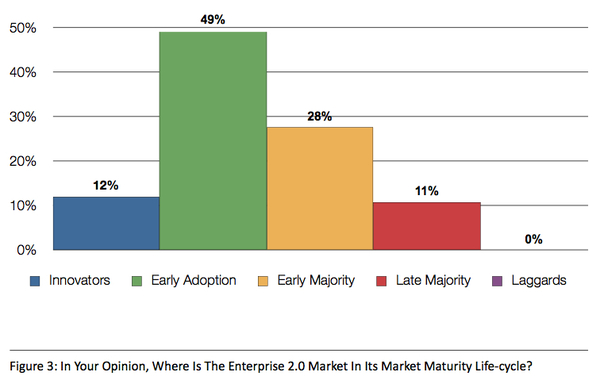
As you can we’re still quite early with over 60% of the companies believing that we are still in the early adoption and/or innovators phase of Enterprise 2.0. I’m not that surprised with these results at all. Based on the conversations I’ve been having with companies in the space, I know this is something they are thinking about and trying to plan for; however they are still not actually acting. This is going to change throughout 2010.
The report says that budgets are quite healthy but with 41% of the companies looking to spend $500k or under, I don’t see how this can be possible. Software vendors such as Jive or SocialText charge around that price for an enterprise size client annually, and we’re just talking about the tool. There’s also needs to be an entire strategy developed and rolled out (not to mention a team created). The budget needs to be spent on developing the strategy and not on paying for the tools (at least not yet).
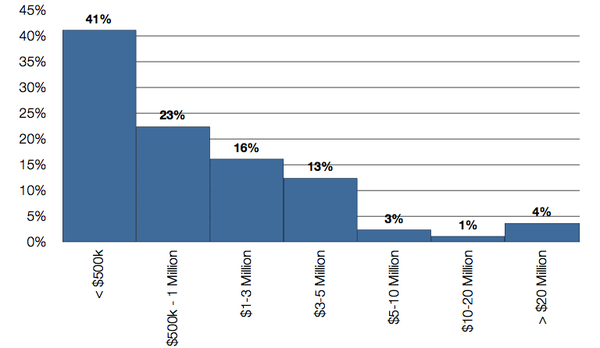
The good news though is that a lot of companies are more realistic with their budgets placing them in the $1 mil+ range which is something that I think is much more realistic for an enterprise. These companies are looking for global solutions and that is going to cost time and money. Personally, I would love some more clarification on exactly where these budgets are going, i.e. tools or strategies?
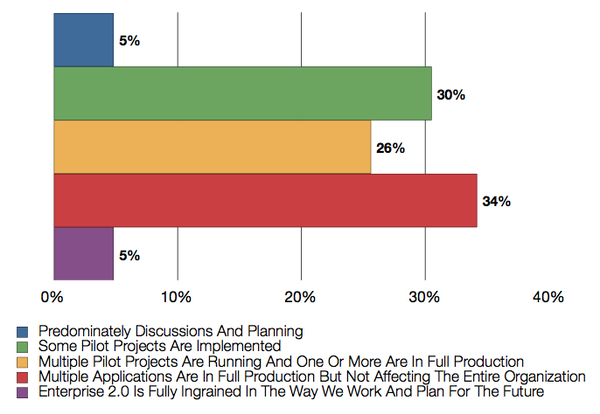
What’s also interesting is that 34% of the companies surveyed said that they have multiple projects in the pipeline which are going to be rolled out. 26% of companies said they have some sort of pilot project running and 30% of companies said that they already have some projects implemented. Keep in mind that this is based off of the 77 companies that responded to the survey so we’re only talking about around 25 companies that actually have multiple projects in the pipeline. The enterprise space is huge, and it’s great to know that a few companies are out there leading the way.
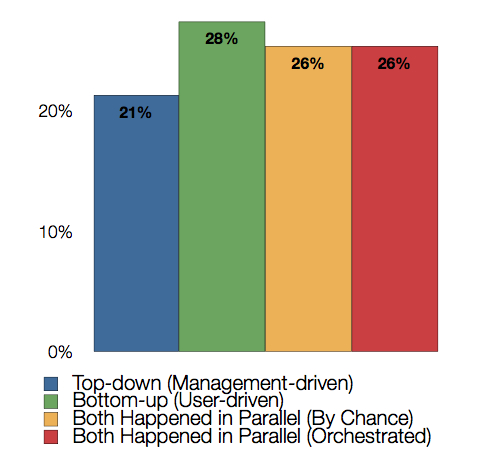
Some of you may be surprised by these numbers but perhaps not. Overall, it looks like there is a pretty even distribution among the four choices as to who is leading the Enterprise 2.0 charge. It appears that management (alone) is not the core driver behind the Enterprise 2.0 push. It’s also interesting to see there is an equal percentage of this shift happening with both users and managers on either a per chance or orchestrated basis. In 2010 I’m hoping we see a much more orchestrated approach to this effort. The fact that the user driven force has been the greatest for E2.0 speaks volumes in that managers are clearly listening to what their employees are saying and doing.
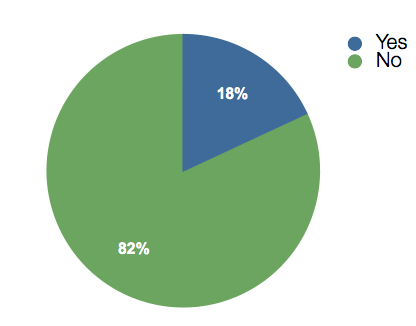
Finally we have the dreaded ROI number to deal with. Clearly most companies are not able to see or understand the ROI from their efforts. I think the key challenge is that ROI for a lot of social media and social business doesn’t come when you expect it to. One day an employee can share something on a collaboration platform that might save the company millions of dollars across the board, however that change might not happen in the first 1-3 months. The point here is that we are talking about an evolution of business. Perhaps as a starting point we can look at things such as increased employee productivity and time saved on trivial tasks (such as email or searching for documents).
I think the report does a great job of shedding more much needed light on the Enterprise 2.0 space, however this report only tells a small part of the story. What do we even mean by Enterprise 2.0? If a company implements an internal collaboration tool such as Jive, are they now an Enterprise 2.0 company? What if they have multiple tools in place? Can you see where the line here gets a a little blurry? Furthermore, I want to understand where the budgets are being spent and how these programs are being deployed. I’m pretty sure that most of these budgets are being spent on tools and not on strategies, I’m also not convinced that these companies are deploying on a global scale; perhaps just departmentally to start. Either way there are still a lot of unanswered questions in my book, especially since I think that a lot of companies are still in the testing phase and are not too sure what to do or what to expect.
What do you think of the report? Have any questions?

Hey Jacob. Thanks for covering the report. Many of your unanswered questions are found in the report which will be available next week on our web site. The budget question is answered specifically. As you've pointed out, many of the members were answering for their initial pilots and not the complete roll-out. The typical global enterprise budget (including internal staff, software, change consulting, and ongoing training and management) is well into the multi-millions. A member (large retailer) just this week received approval from his CEO for a $5M budget.
This is the first report of its kind for the Council. We will be continuing to publish more data regularly. For fun, you can place your bets with our Prediction Market: https://adoptionindex.crowdcast.com.
Thanks again for covering the report.
Hi Jacob,
Excellent post and lots of hard-hitting questions.
Through our experience from this part of the world in Asia, let me see if I can try to address some of the queries:
a.) Enterprise 2.0 (What is it)? – If you personally ask me, it doesn't happen when you implement a tool. It happens when you start living the collaboration/openness culture and start believing that tools like a 'Wiki' or a 'Jive' can bring you a degree of benefit. For me it is more of a thought based approach..
b.) Budgets – It evens out I think, part of it depends on the base cost of the tool itself. A tool might have '0' up-front cost, but the cost of employee time is substantial. This includes time spent to learn it, roll it out successfully, monitor its usage, address user-queries and ensure things move in the right direction.
c.) The ROI part is very hard & I think you are spot on with your example. Investment on an internal collaboration tool is more like spending money for future. For e.g. the data/interactions in a wiki act like a knowledge repository and the organization can easily archive & retrieve as and when required.
@Susan – Looking forward to your report. Please drop us a note at [email protected], whenever it comes out.
You are very welcome, it's an interesting space to be involved in. Glad to know that more details will be provided in the report and also that enterprise companies are more realistic with their budgets at 5 mil+. Are these annual budgets? What percentage is devoted to a one time strategic costs vs ongoing?
I'm definitely hoping to hear more from the Council, in fact I met several members at E2.0 in San Francisco and had a lot of interesting conversations.
Kudos for using Crowdcast, great product and a great team of people behind it!
Thanks! Very interesting to hear your perspective from the Asian market. I agree that E2.0 is more of a mindset and though process but at what point does the company transition? Is it when 51% of the company starts living the collaboration process? When is the tipping point? For budgets I have yet to see a tool with no upfront costs, if you know of one then by all means let me know.
The ROI portion is tricky but also very interesting. I think that once companies start getting more and more involved with E2.0 they will start to see the benefits. The challenge though is going to be able to benchmark a starting point to be able to measure progress.
Thanks for the comment!
There is another way to turn the variables for ROI on their head. Making the initial outlay so very no brainer that the gains can only be on the upside.
I know of social media consulting firms who are tying up with enterprise collaboration platform vendors who use open source to drive down the costs on Proof of concepts to the sub $ 20K level. Yes, Sub $ 20K.
Here's a quick way to enterprise 2.0 nirvana.
1) Identify a proof of concept roll out that costs less than $20K
2) Open the POC for a small group of people and allow brainstorming that could return specific ideas for cost savings and variables on which to measure ROI during a full roll out.
3) This is when you touch ROI, choice of platform, etc.,
You can dumb down adopting enterprise 2.0. Keep looking..
Its interesting to consider the the market maturity life cycle. I'm assuming that the definitions are selected from Geoffrey Moore's “Cross the Chasm / Inside the Tornado” books. I would suggest that by pure market share numbers that this is very much an early adopter market. If the Enterprise 2.0 market is currently in an early majority or late majority (each consists of 33% of the market) then the actual market for enterprise 2.0 use is quite small given the relative size of today's software / services vendors supporting the market today.
Also consider at what point, an enterprise is actually enterprise 2.0 enabled, is it when its first used within the enterprise or when its broadly enabled. Many of OutStart's enterprise 2.0 customers got started with specific uses: sales enablement, customer service, departmental collaboration. Success then fuels other groups use and often the corporation to look at establishing a common technology base. But even for these companies broad adoption is not over night.
Jeff Whitney, OutStart
Hi Jeff,
I agree that it's definitely an early adopter market for now and will most likely stay that way for a little while as companies slowly start to adapt. I think the E2.0 market is actually growing but even now it's not too small. I'm learning about new software vendors such as OutStart on a weekly basis and am actually curious to find out more about the products you guys offer.
I made the same point you addressed, at what point is a company actually considered E2.0 and I don't think there is going to be a set criteria to define that yet. It's interesting to hear your experiences from working with various brands that started out utilizing new technologies on a departmental level and then continued to roll it out from there. That's another reason why I think the market for E2.0 is actually quite large at the moment. Broad adoption is definitely not over night and for an enterprise company it should and will take well over a year.
Thanks for the comment Jeff, email me with more info on OutStart, perhaps we can schedule a call/demo.
Hi Mahendra,
I'd be curious to hear about these firms and what exactly they are doing and who the vendors are that they are working with. I haven't heard of anyone doing this from a consulting or vendor standpoint. Most of the vendor solutions don't offer anything sub 20k (that I know of) and then you need to take into strategy creation and deployment into consideration. Enterprise 2.0 works on scale so rolling it out for a small group of people is not going to be an adequate demonstration of what can be accomplished on a larger scale. Furthermore you don't exactly know when you are going to see ROI, it can happen in a year when one person shares some genius cost saving approach they developed; or it can be in 3 months when the team as a whole becomes more productive, or both.
Enterprise companies need something stable, reliable, and secure. While I don't know much about the vendors you are talking about I do know that eventually companies are going to have to migrate to something solid and moving a team from one platform to another is going to be yet another tedious task. If you're going to do an Enterprise 2.0 shift then you should do it properly from the ground up. I don't think a quick enterprise 2.0 nirvana approach is the way to go about it otherwise all the companies out there would already be implementing.
Thanks for the comment
A lot of E2.0 adoption is about culture, and that's by definition hard and slow. The tech will work itself out, although all those pilots are leaving little silos dropped liked turds all across the intranet.
An interesting challenge in our discussions has been identifying a scale-limited POC that's still relevant to the business (ie, has some real ROI). If it's the sales engineers and professional services guys in the field who need access to subject matter experts from across the company, what % of the company needs to be in the pilot?
Jacob, thanks for digesting the report and asking some good questions. This was a great post.
Hi John,
Culture is definitely hard and slow, it's not easy to go into a company and change decades of thinking. This is why I think we need to focus not on completely revamping how a business works but integrating new methodologies with old ones. You are dealing with very interesting issues and scenarios. I think the best proof of concept for collaboration already exists in terms of how individuals use social networks already. Why not conduct a brief survey amongst company team members? Ideally you obviously want more and more people to use the new tools and technologies but success depends on scale. If you take a small percentage of the company, say 1,000 people then only a small subset of that group are going to contribute, then in order for it to be useful they need to be contributing to things that other people find relevant. This would be a interesting conversation to have.
Jacob,
Thanks for sharing your thoughts on my comment. We, for example, work with a open source, but scalable and stable, behind the firewall platform for internal collaboration. We do offer it at sub 20 K price points for a Proof Of Concept period that is mutually acceptable with the enterprise. When I said small groups, I meant it to be more of a POC use case than the number of users. For eg: We encourage usage for internal collaboration in communication between large project groups in enterprises that are geographically widespread. Internal communication and collaboration being the start point, users do get an opportunity to figure out a use case in a particular workflow (With the assistance of strategy inputs and consulting, like you mentioned) and this is when the concepts of ROI for that enterprise begins to take shape. This is when specific use cases and custom solutions are better visualized on the platform. The platform in itself, need not be discontinued, just because it is open source, ofcourse, assuming that it does address all other enterprise grade concerns.
When I say this, I compare it to today's enterprise upfront investments in sharepoint at a huge price for the platform itself. The ROI in such cases becomes hard to justify and enterprises have ended up using it as mere document repositories and communication platforms, leading to adoption issues. Scaring the enterprise CIO from working out further ROI justifications.
It is tough for enterprises to come up with specific use cases upfront, as most of the users do not even get a full grasp of what enterprise 2.0 can do for them, unless they experience it in someway or the other. Like Jeff mentions in his comments below, some of the enterprises have figured out use cases in sales enablement and customer service. But surely, these are oft repeated use cases and not the only ones which inspire imagination across a broad spectrum of possibilities.
Surely, enterprise 2.0 has much more potential to offer if you give enterprises a way to discovering them with the help of their own internal users, strategists and consultants, without worrying about ROI right at the beginning.
Sounds very interesting, curious to hear more about what you guys are doing when we chat. I definitely agree, current platforms such as Jive, Sharepoint, and Socialtext are around 500k+ minimum for enterprise companies. Enterprise 2.0 has plenty to offer for companies across the board, I like your approach and am definitely looking forward to chatting with you and your team.
Sounds very interesting, curious to hear more about what you guys are doing when we chat. I definitely agree, current platforms such as Jive, Sharepoint, and Socialtext are around 500k+ minimum for enterprise companies. Enterprise 2.0 has plenty to offer for companies across the board, I like your approach and am definitely looking forward to chatting with you and your team.
Pingback: What is Enterprise 2.0? The Basics